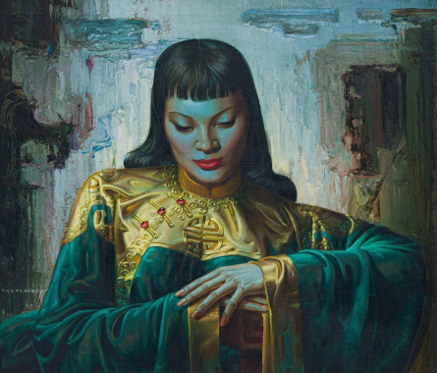BD Art
Medium Value
Buying art, especially for new collectors, can be a complex process because selecting an artwork can be overwhelmingly difficult, not only due to the price of the work, but because there are so many options. Looking at art in galleries, auction catalogues, or even museums, one can see the large variety of different materials used and the varying values attached to these pieces.
Sculpture
Many different mediums are used in sculpture. Traditionally stone, bronze, ceramic, or wood have been used in historical art forms. The value of these sculptures relates as much to the materials from which they are made to the skill with which the objects were created, in a western historical art canon. The value attached to art is often contextual, but, traditionally, a bronze might be a more stable investment due to the value of the material itself rather than something more ephemeral. But, it is important to consider other types of sculpture like the installation work of Kemang Wa Lehulere, which may consist of school desks in conversation with ceramic dogs. Wa Lehulere’s installation sculpture sells for over a million rand in some instances, similar prices to those of Edoardo Villa bronzes, and although it might seem irreconcilable to compare the two, it gives a good example of the price differentiation possible in the sculptural sphere. Although value is inherent in the medium when it comes to bronze, the craft behind the work and the conceptual depth can have an impact.
Painting and Paper
The traditional medium of oil painting is often deemed more valuable financially to works on paper, for instance, as art advisor and collector Fred Scott suggests. But, as with everything, there are always exceptions to the rule. Scott says: “The trend has changed during the past decades, where the creative output of artists is being recognised irrespective of the medium.”
Something like Erased De Kooning Drawing by Robert Rauschenberg might fetch the same price on auction as a Jackson Pollock painting (like Number 32, which sold for
34 098 000 USD from Sotheby’s in 2018) were it ever to be sold, because it is a seminal work in art history. To use Kemang Wa Lehulere as an example again, a painting of ink on paper is on auction at Aspire Art Auctions with the lower estimate at R200 000. This is an example of how the artist’s career trajectory can affect value regardless of medium.
Sam Nhlengethwa is another example one could use, as his editioned lithographs may sell for far lower prices than his unique works in mixed media on paper. Young art collector, entrepreneur and storyteller Zanele Kumalo recently bought a much desired Nhlengethwa work at the Turbine Art Fair called Offline Again. Kumalo has been coveting one of his works since her fine art studies at Rhodes University. Being exposed to his work through her own printmaking led to a curiosity about his practice during a time many black artists were ignored. She says that “he has such an immense gift to capture relatable and captivating domestic scenes”. His observation of the people he encountered in everyday life is integral to the value of his work in which he pays homage to ordinary humans. Kumalo says: “As a fellow lover of jazz, eternal art student and black woman, it fills me with immense pride that things are changing in the art landscape. That we are now collectors and we collect artists that reflect our lived realities is momentous. It’s not lost on me that I have been able to afford to do so. And the title tickles my 21stcentury sensibilities as an analogue kid.” When it comes to deciding on an artwork, Kumalo says “trust your gut”. She adds that a visceral attraction to a work of art is often a deciding factor when she buys a work.
Fred Scott suggests that the market value of sculptors may vary when they produce in other mediums, for instance, the paper work of Ezrom Legae or Gerard de Leeuw sells for a fraction of the price of their bronzes. Scott suggests the same for the difference between the sales value of an Alexis Preller oil painting in comparison to a drawing on auction.
New Media
The value of medium has changed so much since the Neo-Avant Garde of the 1960s. Although the traditional mediums are still most popularly collected, there are many other areas to consider, new media for instance, or even internet art. Digital art curator Carly Whitaker says that because one is not necessarily acquiring an “object” in the same way, value can be difficult to determine. Bogosi Sekukhuni or Tabita Rezaire, for instance, are making and selling digital art in South Africa, but the market is growing slowly.
True Value
It’s important to remember that the true value of any work of art is the value it brings to your life. Art is something that brings life, beauty, and soul into your everyday existence. Love what you buy, visit museums, and you will always get the most value in return.
The Rupert Museum
Robyn-Leigh Cedras, the new director of the Rupert Museum, relates a different kind of value to art. Successful museums, in her opinion, act as nodes of contact that afford the public access and engagement to their cultural heritage. Accessibility is key when it comes to cultural objects of any kind, and the newly renovated Rupert Museum wishes to offer public engagement through their exhibitions and programmes. According to Cedras, “art has the ability to expand the mind and grow shared human experience, especially for young people where the greatest capacity for engagement lies.” The Late Dr and Mrs Rupert started collecting art in the 1940s and were key players through the years bringing visiting art exhibitions to the South African public and taking South African art to international audiences.
The Rupert Museum was opened in 2005, the brainchild of the Late Mrs Rupert, the exhibitions focused on 20th century South African and international art including the likes of Irma Stern, Cecil Higgs, Sydney Khumalo, Ezrom Legae, Lucas Sithole and Maggie Laubser, to mention a few. This has provided the South African public and international visitors the opportunity to revisit well-known artworks by these prominent artists, the very nature of this act, as Cedras states, “implies an inherent desire to share, and safeguard their collection for posterity.”
With the re-opening in May 2019 the building and surrounds create an inviting and open space now featuring the MakerStudio, a multipurpose workshop space, a research library area and café. To further support accessibility there is no entrance fee to the museum, and they have focused on attracting visitors of all ages and backgrounds, breaking away from an audience limited to adults and the art aficionados.
This June the museum hosted a winter school programme for children aged 5–16 years. Another popular initiative has been Museum Saturday on the last Saturday of every month. The programme provides the whole family with an excuse to literally hangout at the museum. There have been art talks by Willie Bester, Keith Dietrich and Thania Pietersen, drawing workshops by Katherine Bull for the adults and clay sculpting with Fawa Conradie for the kids.
The café features a special menu for the day and hosts live jazz in the adjacent courtyard while visitors are further enticed by wine, gin or chocolate tastings. The artworks on exhibition are on three to six month rotations ensuring a constant flow of new works to see and experience. The public programming is supported and informed by the exhibitions providing the visitor with new tools to interact with and unlock meaning in the artworks.






 Sign-up and receive the Business Media MAGS newsletter OR SA Mining newsletter straight to your inbox.
Sign-up and receive the Business Media MAGS newsletter OR SA Mining newsletter straight to your inbox.